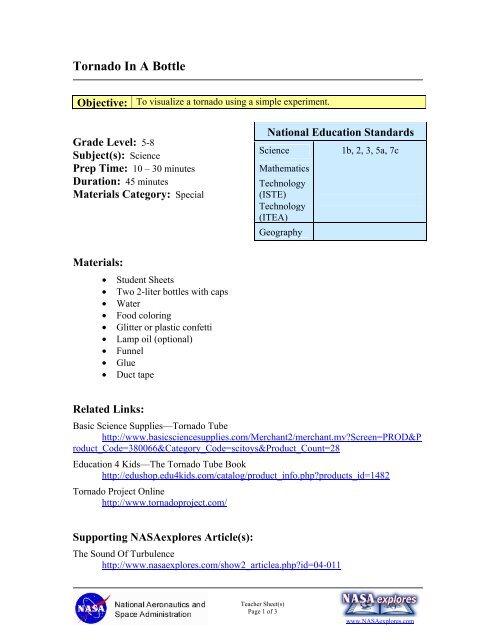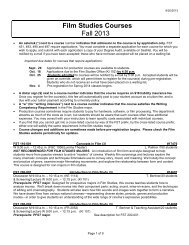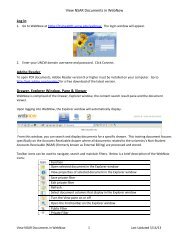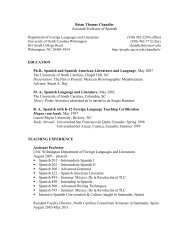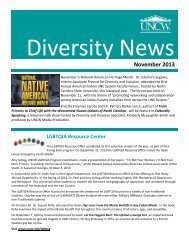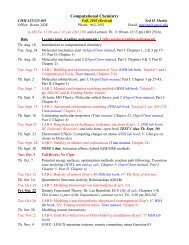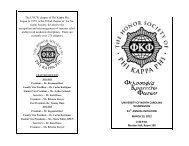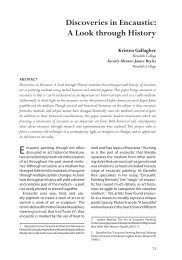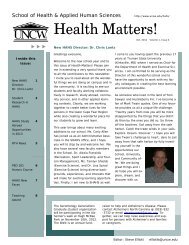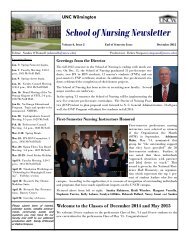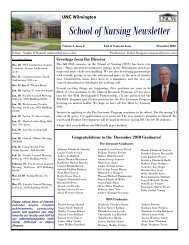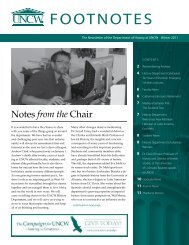NASAexplores 5-8 Lesson: Tornado In A Bottle (All Sheets PDF)
NASAexplores 5-8 Lesson: Tornado In A Bottle (All Sheets PDF)
NASAexplores 5-8 Lesson: Tornado In A Bottle (All Sheets PDF)
You also want an ePaper? Increase the reach of your titles
YUMPU automatically turns print PDFs into web optimized ePapers that Google loves.
<strong>Tornado</strong> <strong>In</strong> A <strong>Bottle</strong><br />
Objective: To visualize a tornado using a simple experiment.<br />
Grade Level: 5-8<br />
Subject(s): Science<br />
Prep Time: 10 – 30 minutes<br />
Duration: 45 minutes<br />
Materials Category: Special<br />
Materials:<br />
• Student <strong>Sheets</strong><br />
• Two 2-liter bottles with caps<br />
• Water<br />
• Food coloring<br />
• Glitter or plastic confetti<br />
• Lamp oil (optional)<br />
• Funnel<br />
• Glue<br />
• Duct tape<br />
Related Links:<br />
Basic Science Supplies—<strong>Tornado</strong> Tube<br />
http://www.basicsciencesupplies.com/Merchant2/merchant.mv?Screen=PROD&P<br />
roduct_Code=380066&Category_Code=scitoys&Product_Count=28<br />
Education 4 Kids—The <strong>Tornado</strong> Tube Book<br />
http://edushop.edu4kids.com/catalog/product_info.php?products_id=1482<br />
<strong>Tornado</strong> Project Online<br />
http://www.tornadoproject.com/<br />
Supporting <strong>NASAexplores</strong> Article(s):<br />
Teacher Sheet(s)<br />
Page 1 of 3<br />
National Education Standards<br />
Science 1b, 2, 3, 5a, 7c<br />
Mathematics<br />
Technology<br />
(ISTE)<br />
Technology<br />
(ITEA)<br />
Geography<br />
The Sound Of Turbulence<br />
http://www.nasaexplores.com/show2_articlea.php?id=04-011<br />
www.<strong>NASAexplores</strong>.com
<strong>Tornado</strong> <strong>In</strong> A <strong>Bottle</strong><br />
Teacher Sheet(s)<br />
Pre-lesson <strong>In</strong>structions<br />
• Duplicate the Student <strong>Sheets</strong> (one per group).<br />
• Divide the class into groups of four. You can vary the group size based on the<br />
number of materials that you have.<br />
• Drill a 3/8-inch hole in the center of each cap. Connect the caps to the top of each<br />
other using glue. Reinforce this with duct tape wrapped around the sides. Be sure<br />
that the caps will still screw onto the 2-liter bottles. This step can be avoided if<br />
you choose to buy a “tornado tube.” See the Related Links.<br />
• Use the funnel to prevent spilling the water when pouring it into the 2-liter<br />
bottles. One can be placed at each faucet or source of water for the groups to<br />
share.<br />
Background <strong>In</strong>formation<br />
Wind speeds in tornadoes range from values below that of<br />
hurricane speeds to more than 300 miles per hour. Unlike<br />
hurricanes, which produce high speed winds over large areas, the<br />
maximum winds in tornadoes are often confined to extremely small<br />
areas. They change greatly over very short distances, even within<br />
the funnel itself. The tales of complete destruction of one house<br />
next to one that is totally undamaged are true!<br />
<strong>In</strong> 1971, Dr. T. Theodore Fujita of the University of Chicago devised a six-category scale<br />
to classify U.S. tornadoes. The six categories are named F0-F5. These categories are<br />
based upon the estimated maximum winds occurring within the funnel. The Fujita<br />
<strong>Tornado</strong> Scale (or the "F Scale") has become the standard scale for estimating wind<br />
speeds within tornadoes based upon the damage done to buildings and trees. <strong>In</strong> fact, all<br />
tornadoes are now assigned an F scale. It is used by the National Weather Service and<br />
engineers to investigate the damage and structure of tornadoes.<br />
Today’s activity will have the students building a tornado simulator. This<br />
simulator will show the basic characteristics of a tornado. For visibility<br />
purposes, students will use water, instead of air, for their tornadoes.<br />
<strong>Tornado</strong>es are called vortices based on their properties. Once you have<br />
started it, the water will exit through the hole forming a vortex, similar to a<br />
tornado. To see the process even better, students will add oil, food<br />
coloring, or confetti to the water.<br />
Teacher Sheet(s)<br />
Page 2 of 3<br />
www.<strong>NASAexplores</strong>.com
Guidelines<br />
1. Read orally the 5-8 <strong>NASAexplores</strong> article, “The Sound Of Turbulence.”<br />
2. Distribute the Student <strong>Sheets</strong>.<br />
3. Ensure that each group has two 2-liter bottles, a tornado cap, and access<br />
to water.<br />
4. Have each group fill one of their 2-liters about three-fourths full.<br />
5. Have each group screw on the cap connector.<br />
6. Have each group screw on the empty 2-liter bottle. The tornado<br />
simulator should look like an hourglass.<br />
7. <strong>In</strong>struct each group to flip over the tornado simulator. The groups need<br />
to swirl it to start the process.<br />
8. Have each group record their observations.<br />
9. Have students add oil, food coloring, or confetti, depending on what you<br />
have available.<br />
10. Repeat the experiment, and have the groups record their observations.<br />
Discussion / Wrap-up<br />
• Discuss some of the characteristics of tornadoes.<br />
• Remind students of safety procedures during tornadoes. Ask the students if they<br />
have a weather safe place to go that has a flashlight, radio, water, and blankets.<br />
This safe place should be underground if possible, or in the interior of their<br />
homes, where there are no windows.<br />
• Discuss some of the groups’ observations with the class.<br />
Extensions<br />
• Order the Taming The <strong>Tornado</strong> Tube activity book by Steve Spangler for more<br />
ideas.<br />
• Try varying the temperature or amount of the water, the pressure in the bottles, or<br />
use another liquid besides water to see if it changes the results.<br />
Teacher Sheet(s)<br />
Page 3 of 3<br />
www.<strong>NASAexplores</strong>.com
<strong>Tornado</strong> <strong>In</strong> A <strong>Bottle</strong><br />
Student Sheet(s)<br />
Background <strong>In</strong>formation<br />
Wind speeds in tornadoes range from values below that of<br />
hurricane speeds to more than 300 miles per hour. Unlike<br />
hurricanes, which produce high speed winds over large areas, the<br />
maximum winds in tornadoes are often confined to extremely small<br />
areas. They change greatly over very short distances, even within<br />
the funnel itself. The tales of complete destruction of one house<br />
next to one that is totally undamaged are true!<br />
<strong>In</strong> 1971, Dr. T. Theodore Fujita of the University of Chicago devised a six-category scale<br />
to classify U.S. tornadoes. The six categories are named F0-F5. These categories are<br />
based upon the estimated maximum winds occurring within the funnel. The Fujita<br />
<strong>Tornado</strong> Scale (or the "F Scale") has become the standard scale for estimating wind<br />
speeds within tornadoes based upon the damage done to buildings and trees. <strong>In</strong> fact, all<br />
tornadoes are now assigned an F scale. It is used by the National Weather Service and<br />
engineers to investigate the damage and structure of tornadoes.<br />
Today’s activity will have you building a tornado simulator. This simulator<br />
will show the basic characteristics of a tornado. To see it better, you will use<br />
water, instead of air, for your tornado. <strong>Tornado</strong>es are called vortices based<br />
on their properties. Once you have started it, the water will exit through the<br />
hole forming a vortex, similar to a tornado. To see it even better, you can<br />
add oil, food coloring, or confetti to the water.<br />
Materials<br />
• Two 2-liter bottles<br />
• <strong>Tornado</strong> cap<br />
• Water<br />
• Food coloring<br />
• Glitter or plastic confetti<br />
• Lamp oil (optional)<br />
• Funnel<br />
Procedure<br />
1. Be sure your group has two 2-liter bottles and the tornado cap.<br />
Student Sheet(s)<br />
Page 1 of 2<br />
www.<strong>NASAexplores</strong>.com
2. Choose one of the 2-liters. Fill it three-fourths full of water (does not have to be<br />
exact).<br />
3. Screw the tornado cap onto the top of the 2-liter bottle.<br />
4. Screw the empty 2-liter bottle to the top of the tornado cap. Your set-up<br />
should look like the figure on the right.<br />
5. Quickly, but carefully, flip the two 2-liter bottles over, so that the empty<br />
one is one the bottom.<br />
6. Grabbing the top of the tornado simulator, swirl it around to start it.<br />
7. Answer these two questions, and record other observations on the line<br />
below:<br />
a. What is happening to the water as it leaves the upper 2-liter bottle?<br />
b. What is happening to the water as it enters the lower 2-liter bottle?<br />
c. Other observations: ___________________________________________<br />
8. Repeat the experiment again. Did you observe the same things? Record any<br />
differences here: ___________________________________________________<br />
9. With the full 2-liter bottle on the bottom, remove the upper 2-liter bottle and the<br />
tornado cap.<br />
10. Add oil, food coloring, or confetti (whatever your teacher provides) to the water.<br />
Use the funnel to prevent spilling it.<br />
11. Attach the tornado cap and empty 2-liter bottle back on top.<br />
12. Repeat the experiment.<br />
13. Record your new observations:<br />
a. Can you see what is happening better now?<br />
b. If you used the oil, what happened to it during the tornado?<br />
c. If you used confetti, what happened to it during the tornado?<br />
d. Note any new observations: ____________________________________<br />
Student Sheet(s)<br />
Page 2 of 2<br />
www.<strong>NASAexplores</strong>.com


